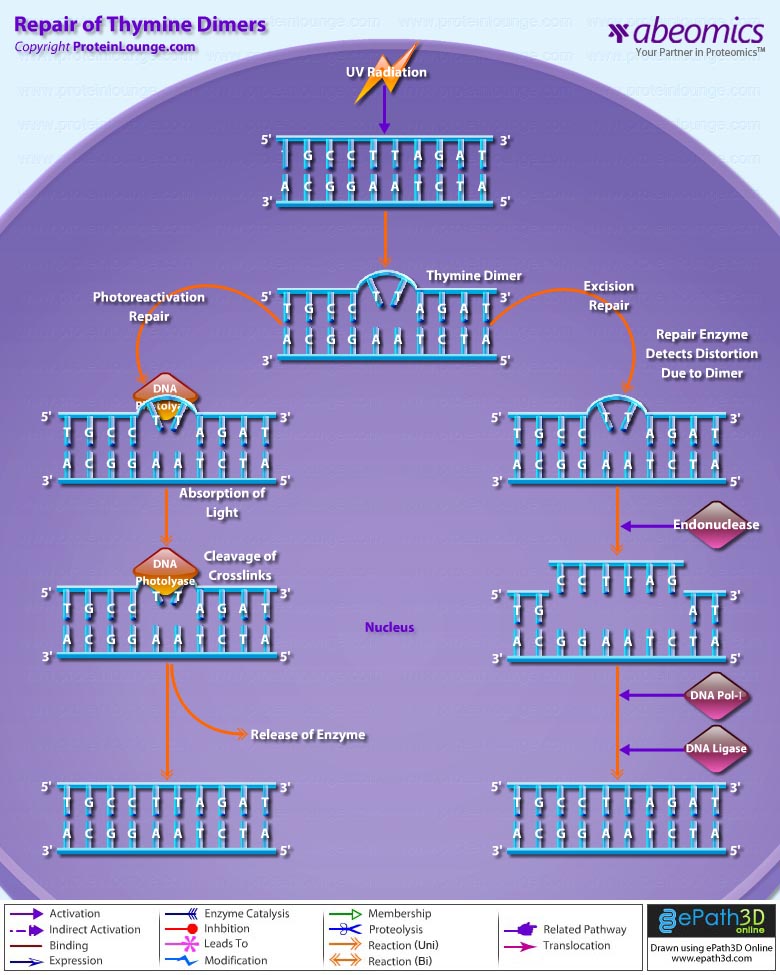Which Mechanism Is Used To Repair A Thymine Dimer In Dna

Irradiation of Dna by UV (ultraviolet light) causes lesions, such as cyclobutane-pyrimidine dimers or 6-4PPs (6-iv pyrimidine pyrimidone). The nearly common covalently linked adjoining pyrimidines are T-T (thymine dimers), T-C (thymine-cytosine dimers) and C-C (cytosine-cytosine dimers). T-T dimers cause kinks in the Deoxyribonucleic acid strand that prevent both replication and transcription of that part of the Dna. Because they block Deoxyribonucleic acid replication (and therefore prevent cells from reproducing), T-T dimers and other forms of UV damage cannot exist inherited, and thus do not plant mutations. Such kinds of DNA damage are known as premutational lesions because they prevent both transcription and replication of the genes in which they are present, and these lesions are fatal if they go uncorrected (Ref. 2).
Several mechanisms are bachelor for the removal or correction of T-T dimers from Dna depending upon the circumstances of the cell. Sure organisms posses a photoreactivating enzyme called photolyase, which contains chromophores capable of capturing photons of blueish light (of wavelength 350-450 nm). Photolyase start detects and binds to the damaged Deoxyribonucleic acid site (a pyrimidine dimer). Then it uses calorie-free energy captivated from the visible range (lambda = 370 nm) to oxidize the cyclobutane ring and catechumen the dimer into monomers without disrupting the double strands. Finally, the enzyme dissociates from the DNA and the damage is repaired. Recognition of cyclobutane-pyrimidine dimers by photolyase is structure specific and the enzyme is non influenced by the nucleotide content surrounding the dimer. Photoreactivation, notwithstanding, is affected by the nucleotide content of the pyrimidine dimers. The cyclobutane-pyrimidine dimers photolyase is institute in prokaryotes, lower and college eukaryotes, but their being in placental mammals is still unknown (Ref.1). Hence, the repair of T-T dimers in humans takes place through an excision repair mechanism. This repair machinery does not require calorie-free and instead of simply breaking the bonds of the T-T dimer as was done by photolyase, it excises the region of damaged nucleotides. A protein circuitous recognizes the distortion in the DNA caused by the T-T dimers and a pair of endonucleases makes nicks in the DNA strand on either side of the T-T dimer. Generally, the nicks are 12 nucleotides apart and the Dna between the nicks is removed. Dna polymerase I fills in the gaps left behind, and DNA ligase seals the final nick in the DNA. In addition, other mechanisms such every bit mutagenic repair or dimer bypass, recombinational repair, cell-cycle checkpoints, apoptosis, and certain alternative repair pathways are likewise operative in diverse organisms for the removal or correction of T-T dimers (Ref. 2).
The UV component of sunlight is responsible for the induction of pare tumors, almost notably basal cell and squamous cell carcinomas and melanomas (Ref. 3). The presence of UV induced dimers in the Deoxyribonucleic acid is damaging, and it may crusade a mispairing as the strand is being copied or may terminate replication altogether. Unless repaired, pyrimidine dimers may lead to blockage of transcription, mutations, cell death and cancer (Ref. 4).
References:
1.Photorepair prevents ultraviolet-induced apoptosis in homo cells expressing the marsupial photolyase factor.
Chigancas V, Miyaji EN, Muotri AR, de Fatima Jacysyn J, Amarante-Mendes GP, Yasui A, Menck CF.
Cancer Res. 2000 May 1; sixty(9): 2458-63.
2.UV-induced DNA damage and repair: a review.
Sinha RP, Hader DP.
Photochem Photobiol Sci. 2002 Apr; 1(4): 225-36. Review.
3.Photoreactivation of UV-induced cyclobutane pyrimidine dimmers in the MFA2 factor of Saccharomyces cerevisiae.
Morse NR, Meniel V, Waters R.
Nucleic Acids Res. 2002 Apr 15; thirty(8): 1799-807.
4.Chromatin structure modulates DNA repair by photolyase in vivo.
Suter B, Livingstone-Zatchej M, Thoma F.
EMBO J. 1997 April fifteen; 16(8): 2150-60.
Which Mechanism Is Used To Repair A Thymine Dimer In Dna,
Source: https://www.abeomics.com/repair-of-thymine-dimers
Posted by: villanuevafroce1969.blogspot.com


0 Response to "Which Mechanism Is Used To Repair A Thymine Dimer In Dna"
Post a Comment